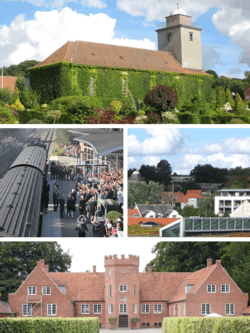Hadsten
| Hadsten | |
|---|---|
 | |
| Motto(s): "Et hestehoved foran" | |
 Hadsten Location in Denmark | |
| Coordinates: 56°20′00″N 10°03′00″E / 56.33333°N 10.05000°ECoordinates: 56°20′00″N 10°03′00″E / 56.33333°N 10.05000°E | |
| Country | Denmark |
| Region | Central Denmark Region |
| Municipality | Favrskov Municipality |
| Founded | 3 September 1862 |
| Government | |
| • Type |
Municipal council A (11)
C (1)
F (1)
O (2)
V (9)
Ø (1) |
| • Mayor | Nils Borring (A) |
| Area | |
| • Total | 5.29 km2 (2.04 sq mi) |
| Elevation | 18-56 m (−166 ft) |
| Population (2014) | |
| • Total | 7,961 |
| • Density | 1,500/km2 (3,900/sq mi) |
| • Municipal | 47,117 |
| Time zone | UTC+1 (CET) |
| • Summer (DST) | UTC+2 (CEST) |
| Postal code | 8370 Hadsten |
| Area code(s) | (+45) 86 |
| Website | http://www.favrskov.dk/ |
Hadsten (Danish: [ˈhæːˌsden]) is a city in central Denmark with a population of 8,028 (1 January 2016),[1] and is the largest city in Favrskov Municipality,[2] located in Region Midtjylland in Central Jutland. Until 1 January 2007 it was the site of the municipal council of the now former Hadsten municipality. Other names for Hadsten are: Hadsten Stationsby.
Hadsten has many educational institutions, including a technical school, gymnasium (Secondary school), and folk high school. Hadsten is famous for having one of the largest model railways in Europe.[3] Besides that, Hadsten has the shortest pedestrian street in Europe.
Pronunciation of the town's name has often been the subject of discussion, since locals pronounce the name with a silent "d"; as "Ha'sten".
History
Archaeological digs around the city have shown that people have lived in Lilleådalen as far back as 2,000 BC in the Nordic Stone Age. The excavation at the water mill, which later became known as Hadsten Mølle, have revealed the remains of an even older water mill from around the 1190's in the early High Middle Ages. The present mill originates from the 1400s during the Clausholm Castle era, and later gained its present name of Hadsten Mølle.
Hadsten was mentioned for the first time in 1432 as Halstiern suggesting to come from the Old Norse word tjærn which means "little lake", while the neck also in Old Danish refers to the narrowing the small river valley have of Kollerup Gods. The water level this river at that time has stood 2–3 meters higher than it is today - which is why the valley was marked by lakes.
The modern city was founded on 3 September 1862, when Den østjyske længdebane (The Eastern Jutland Railway) opened. In 2012, the city celebrated its 150th anniversary, with a visit by Frederik, the Crown Prince of Denmark and his wife, Mary, Crown Princess of Denmark.[4] The city was at the plant of the East Jutland stretch of railway line, which was officially inaugurated on 3 September 1862. Therefore, this date is seen as the city's founding. In September 2012 celebrated its 150th anniversary with the visit of Crown Prince Frederik and Crown Princess Mary.
One of the most advanced buildings in Denmark is in Hadsten; it functions as a café, library and auditorium.
Geography
Hadsten’s average elevation above sea level is 44 meters.[5]
Urban districts of Hadsten
- Hadsten Stationsby, current center of the city.
- Neder- and Over Hadsten, original villages, now integrated into the city.
- Vinterslev, original village, now integrated into the city.
Notable people
- Frederik Bergmann Larsen (1839 – 1916 in Hadsten) a famous Danish doctor, known by some as the miracle doctor
- Morten Bisgaard (born 1974 in Hadsten) a Danish football coach and former professional football player, with over 350 club caps, including over 100 for Derby County F.C. he played eight games and scored one goal for the Denmark national football team
- Jonas Bager (born 1996 in Hadsten) a Danish professional footballer who plays for Randers
Gallery
- Hadsten Station
- Søndergade
- "Lillåmarked", an annual festival and gathering in Lilleå park
 "Det Nye Løb" (The New Race), annual cycling race
"Det Nye Løb" (The New Race), annual cycling race- Skt. Pauls kirke
- Over Hadsten church
 Over Hadsten
Over Hadsten- Kollerup Manor
- Hadsten Højskole, a folk highchool
- Hadsten Husholdningsskole (1938), originally a school for housekeeping now a vocational school
- Hadsten Hallen, a fair and exhibition centre
- Sløjfen (sports and culture centre)
 Retro World, a retro Bed & Breakfast themed on the 60s and 70s in Denmark.
Retro World, a retro Bed & Breakfast themed on the 60s and 70s in Denmark.
Sister cities
References
- ↑ "BEF44: Population 1st January, by urban areas" database from Statistics Denmark
- ↑ "De største byer" Archived 11 December 2013 at the Wayback Machine.. Retrieved 2012-09-27.
- ↑ Modelbane Europa(website)
- ↑ "Frederik and Mary Visit Favrskov". Royal Hats blog.
- ↑ Geonames. "Hadsten, Denmark". Retrieved 5 May 2012.
- ↑ "Ystävyyskuntatoiminta" (in Norwegian). City of Saarijärvi. Archived from the original on 6 December 2013. Retrieved 1 June 2012.
External links
| Wikimedia Commons has media related to Hadsten. |